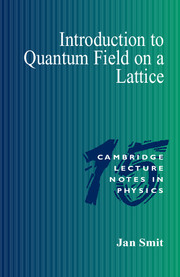Book contents
- Frontmatter
- Contents
- Preface
- 1 Introduction
- 2 Path-integral and lattice regularization
- 3 O(n) models
- 4 Gauge field on the lattice
- 5 U(1) and SU(n) gauge theory
- 6 Fermions on the lattice
- 7 Low-mass hadrons in QCD
- 8 Chiral symmetry
- Appendix A SU(n)
- Appendix B Quantization in the temporal gauge
- Appendix C Fermionic coherent states
- Appendix D Spinor fields
- Notes
- References
- Index
Preface
Published online by Cambridge University Press: 05 November 2009
- Frontmatter
- Contents
- Preface
- 1 Introduction
- 2 Path-integral and lattice regularization
- 3 O(n) models
- 4 Gauge field on the lattice
- 5 U(1) and SU(n) gauge theory
- 6 Fermions on the lattice
- 7 Low-mass hadrons in QCD
- 8 Chiral symmetry
- Appendix A SU(n)
- Appendix B Quantization in the temporal gauge
- Appendix C Fermionic coherent states
- Appendix D Spinor fields
- Notes
- References
- Index
Summary
She [field theory] is not a robust mate ready to pitch in and lend a helping hand. She is a haunting mistress, refined, and much too beautiful for hard work. She is at her best in formal dress, and thus displayed in this book, where rigor will be found to be absolutely absent.
Bryce S. DeWittSince the above characterization appeared [1] in 1965 we have witnessed great progress in quantum field theory, our description of fundamental particles and their interactions. This book displays her in informal dress, robust and ready to give results, rigorous, while at a pedestrian mathematical level. By approximating space–time by a collection of points on a lattice we get a number of benefits:
it serves as a precise but simple definition of quantum fields, which has its own beauty;
it brings to the fore and clarifies essential aspects such as renormalization, scaling, universality, and the role of topology;
it makes a fruitful connection to statistical physics;
it allows numerical simulations on a computer, giving truly nonperturbative results as well as new physical intuition into the behavior of the system.
This book is based on notes of a lecture course given to advanced undergraduate students during the period 1984–1995. An effort was made to accomodate those without prior knowledge of field theory.
- Type
- Chapter
- Information
- Introduction to Quantum Fields on a Lattice , pp. xi - xiiPublisher: Cambridge University PressPrint publication year: 2002

